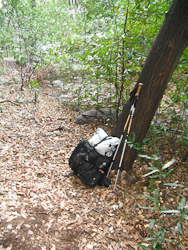Fortunately, I live 5 minutes from mountain trails that lead hikers from desert-like chaparral to cool, riparian canyons, streams, rich wildlife and… lots of people. Hey, it’s LA after all
The farther I hike into the hills, the thinner the crowds. Most of the local backpacking camps are about 3 miles in from the trailhead. By Friday night, most camps are full; on Saturdays, finding an actual campsite (picnic table, fire ring and tidy, tent-size dirt lot), is nearly impossible, especially during warmer months.
One way I beat the crowds, tent cities
and all that comes with people, is to “stealth camp.” When backpacking solo or with my wife, Amber, we usually walk through the busy campsite and continue along the trail, keeping an eye out for a hidden place to sleep. I look for a space near water (but not too close as to disturb drinking holes for wildlife) but a nice distance from the trail.  I don’t want to be seen or heard. My personal “private Idaho” must be relatively level, high enough to avoid flooding yet not exposed enough for people to see. Ideally, I want to be tucked in or against a large bush, rock or a small tree with plenty of space to move around.
I don’t want to be seen or heard. My personal “private Idaho” must be relatively level, high enough to avoid flooding yet not exposed enough for people to see. Ideally, I want to be tucked in or against a large bush, rock or a small tree with plenty of space to move around.
Going stealth gives me the privacy and solitude I get from back country travel. It has other advantages as well: Since I cook on the trail before arriving at camp, it minimizes food smells which attract unwanted animal visits. And since the space I choose is not shared with other travelers, there are no food scraps from other campers. Therefore, stealth camps are usually not on most bear food routes.
I often bring our dog backpacking, and when we stay in designated campground, he always finds morsels embedded in the dirt–anything from potato skins to spaghetti noodles, often spread out on the dirt or dumped in a fire ring.
Camping outside of a designated site is also cleaner, usually has more vegetation and has better tree limbs to hang a bear bag.
Challenges of Stealth
With stealth camping comes with a few inconveniences, which some may not be comfortable with. There is a greater sense of being alone; if there is an emergency, you don’t have neighbors to call on. You also have to really practice Leave No Trace. That means you don’t work on your bushcraft skills; create a campsite by cutting limbs, excessive rock distribution and turning logs, etc., you work yourself into the space available and enjoy it. You also have to be aware of ant activity and animal habitat. You do not want to sleep over anyone’s home.
I’ve spoken with Angeles National Forest rangers about camping off-site. They tell me that dispersed camping is perfectly legal. There are a few rules on dispersed camping, which everyone should already practice.
So, give stealth a try; help relieve the pressure of crowded camps and get back into nature!

